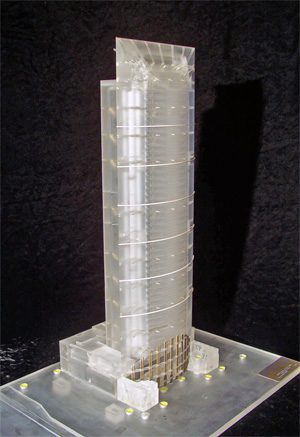PRESSURE INTEGRATION METHOD
 State-of-the-art pressure instrumentation allows simultaneous local pressure measurements at about 1,000 locations on a pressure model. These pressures can be converted to loads on the building and can be integrated at each sampled time interval to determine the overall structural load time histories. Generalized forces are calculated using the measured load distribution with the mode shape. State-of-the-art pressure instrumentation allows simultaneous local pressure measurements at about 1,000 locations on a pressure model. These pressures can be converted to loads on the building and can be integrated at each sampled time interval to determine the overall structural load time histories. Generalized forces are calculated using the measured load distribution with the mode shape.
The information obtained from the pressure integration method is generally equivalent to that available from the force-balance tests. There are a number of differences between the force-balance and pressure tests.
-
The integration of wind loads on all building surfaces includes the correlation and coherence of the force components in the x, y and torsional directions.
-
The variation of wind loads with height is available in detail and can be used together with any variation of mode shapes.
-
Estimates of the torsional contribution to the generalized forces are significantly improved over the force-balance analysis.
-
A pressure test is inherently more robust.
-
The construction of a pressure model is more time consuming; hence, the information on overall loads takes longer to develop than by using a force-balance model.
-
For very complex geometry or for multiple towers, a large number of pressure taps is required to cover all building surfaces. It requires a large interior space in the pressure model, and hence sometimes integration resolution can be compromised.
In general, the force-balance test and the pressure integration method can be treated as equivalent. It is generally recommended that a force-balance study be carried out if structural load information is required urgently or if there is good possibility of geometry changes. The pressure integration method is more cost effective since only one model and one set of tests are required to obtain both structural loads and local pressure information.
Additional Information:
|